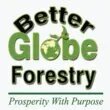PLANTATION BLOCK IN KIAMBERE.
This plantation block in Kiambere is 12 years old. The brown colour on some stems is earth brought by termites, that however don’t affect the trees. Melia volkensii or mukau in its vernacular name, is resistant against termite attacks.

YOUNG MELIA SEEDLINGS FOR TRANSPLANTING
Very young Melia volkensii seedlings, in nursery, at the stage of pricking out into individual containers. This is an indigenous tree species, superbly adapted to Kenyan drylands, but needing special care when propagating. BGF has mastered these techniques, and for many years ran the biggest melia nurseries in Kenya.

KIAMBERE PLANTATION FROM THE AIR.
Aerial image of Kiambere plantation at the beginning of the rainy season, when the melia trees start sprouting their leaves. The plantation is at the eastern shore of Lake Kiambere, a man-made reservoir whose primary function is electricity generation.

YOUNG MELIA SEEDLINGS IN THE FIELD
BGF has been, and still is, a pioneer in dryland afforestation in East Africa. This shows through species choice, planting and management techniques. The most sensitive time for tree planting is right at establishment, and up to a period of one year. These young trees are making it, through proper care. They are less than one year old.

BUFFALO-PROOF ELECTRICAL FENCE IN NYONGORO
To protect the trees against damage by buffaloes, we constructed a solar-powered electrical fence, over more than 6km. The spikes that are protruding towards the right will touch the animals and deter them, before they can damage the fence itself.

ACACIA PLOT FOR STUDY IN GUM ARABIC PRODUCTION
True to our reputation as dryland afforestation specialists, in Kiambere we tried out Acacia senegal, for production of gum Arabic, an industrial commodity with many applications in the beverage, pharmaceutical, health and printing industries.

BIODIVERSITY IN OUR PLANTATIONS
Despite establishing homogeneous plantations, we respect biodiversity, like this mighty baobab tree growing amid melia. This helps us to quality for Forest Stewardship Council certification, whose stringent requirements are a guarantee for responsible planting and management practices.

YOUNG MELIA PLANTED IN NYONGORO.
A young plantation block in Nyongoro during the rainy season. The trees are almost one year old, and the surrounding vegetation of grasses and weeds needs to be kept in check. This is mostly done by mechanical means.

MECHANISATION IN OUR NYONGORO PLANTATION
We have a fleet of tractors with adapted implements, like trailers for transporting seedlings and other things, for mowing grass, drills for planting, for watering and so on.

MORE MECHANISATION.
The flat coastal plains of Nyongoro are apt to mechanized operations, including land clearing and preparation. The photo shows a Caterpillar D6 deepening a depression for collecting rainwater, to be used for dry season irrigation of young seedlings.

DRY SEASON VIEW OF NYONGORO PLANTATION
After some 10-11 years the melia trees in Nyongoro look like this, at least in the dry season. Next, they will be thinned to provide more space for growing thick. The expected rotation time is 20 years, by which their diameter will be higher than 40cm and good for processing in a sawmill.

FAST-GROWING MELIA
On good soil the trees grow fast. This one is 13 years old, and our site manager is standing beside it. The rotation age for melia is expected to be 20 years, with logs of over 40cm diameter, for sawmilling.

OUR FIELD OFFICE IN DOKOLO
Our field offices in Dokolo district, northern Uganda. To keep things simple, they are located at the nursery site, where seedlings are produced for planting with farmers, in our Ugandan farmers programme.

DRONE IMAGE OF NYONGORO PLANTATION
This is a drone image of our Nyongoro plantation, in Lamu county. It was taken in the heart of the dry season, when the melia trees have shed their leaves as a drought-coping mechanism.

AGRO-FORESTRY IN DOKOLO DISTRICT
BGF has two different planting models. One is the conventional one of plantation blocks, on leased land, like in Kiambere and Nyongoro, and the other one is in an agro-forestry lay-out, with farmers. Trees are widely spaced, allowing for food crops to be grown in between the lines. This picture is in Northern Uganda, with the tree species Melia azedarach.
AGRO-FORESTRY IN NORTHERN UGANDA
BGF’s farmer programme in Northern Uganda, with many partner-farmers getting their seedlings from our nursery in Dokolo township. The tree species is Melia azedarach, well adapted to the climate.
AGROFORESTRY IN SEMI-ARID KENYA
Our farmer programme in the Seven Forks area covers thousands of partner-farmers, and aims for timber production and poverty alleviation through soil & water conservation leading to higher crop yields. The timber is mahogany of high value, from the species Melia volkensii known as “mukau” in Eastern Kenya, well appreciated by farmers.





